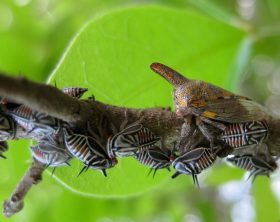Insects may be small and crunchy, but they demonstrate behaviors that are just as relatable to humans as the cute and cuddly animals that more often fascinate us.
By Katie DeGraff
Birds chirp. Chimpanzees groom. Baby bears scamper up trees. We’re fascinated by their songs, behaviors and first steps, as is apparent by the thousands of YouTube videos often shared on social media.
But what about beetles? Grasshoppers? Caterpillars?
Like all living creatures, insects are motivated by the basics: food, safety, reproduction and resources. And they represent more than half of all described animal species. “They’re small and crunchy, but they have the same fundamental behaviors as other animals,” says Jen Hamel, assistant professor of biology.

Yet those “pests” demonstrate behaviors that are just as relatable to humans as the cute and cuddly animals that are more often the subject of human interest. Take, for example, oak treehoppers, commonly found on oak trees like those on Elon’s campus. These charismatic bugs are about a centimeter long, hang out on the ends of branches and exhibit maternal care. Mothers remain steadfastly at their kids’ side (about 50 babies hatch at a time) and defend them from spiders and other predators with the only means at her disposal: a roundhouse kick. The baby insects alert their mother to an approaching predator by doing the wave, just like rowdy baseball fans.
And it all happens in plain sight. You just have to know to look for it. When fireflies flash on summer evenings, they’re signaling to potential mates who are below in the grass. If the presumptive mate is receptive, the signal is returned. When bees take a deep dive under the leaf litter, they’ve bringing provisions to their nest. And much like humans in different regions of the country, katydids exhibit different dialects from mountaintop to mountaintop. But insect behavior is about so much more than reproduction. A single insect species doesn’t exist in isolation. Hamel’s research explores how community members, such as predators and parasites, shape behavior.

Hamel is also in the final stages of co-authoring a children’s book, “Bug Camp: Where Every Day Is An Adventure,” focused on insects and science. It will be available in September. The book is based on a summer earlier in Hamel’s career when she worked as a counselor for Bug Camp, an experiential learning science camp for rising fifth through seventh graders. The book, targeted to third- through sixth-grade readers, is a snapshot of that experience. “We provide a lot of information about insects, but we also explicitly include content about what science is and how it works, and there are hands-on activities in each section—many of which are experiments that anyone can do at home,” she says.
Whether at home, at work or out for a walk, Hamel says it’s very likely you’re in close contact with any number of insects. And just maybe observing their behavior can teach you something about your own.


